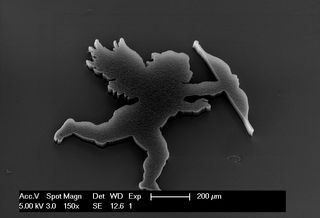Cute Cupid Is Year's Tiniest Valentine

If this Cupid hit you with an arrow, you'd never feel it — its weapon is a mere fraction of the width of a human hair.
But this tiny Valentine is an example of big technology. Just a few hundred nanometers from foot to bow (a nanometer is a billionth of a meter), Cupid here is made from carbon nanotubules in a process that has been used in fields as diverse as mining and health care.
To make the tiny Cupid, physics students at Brigham Young University (BYU) first created the bow-wielding cherub shape with microscopic iron beads. They then blasted the beads with a puff of heated gas, which triggers the microscopic beads to transform into carbon nanotubules only 20 atoms across.
The resulting structure is as delicate as new love.
"Blowing on it or touching it would destroy it," BYU physics professor Robert Davis said in a statement.
Davis and his colleagues have ways to take the technology past the realm of fragile Valentines, however. Along with BYU physicist Richard Vanfleet, Davis has developed methods to strengthen the nanotube structures with metals and other materials.
One application is building itsy-bitsy nanofilters with great precision — these filters have holes about a tenth the circumference of a human hair, each perfectly spaced. Such nano-filters can be used in compressed gas systems in mining, health care and scuba diving, Davis said.
Sign up for the Live Science daily newsletter now
Get the world’s most fascinating discoveries delivered straight to your inbox.
Follow Stephanie Pappas on Twitter @sipappas or LiveScience @livescience. We're also on Facebook & Google+.

Stephanie Pappas is a contributing writer for Live Science, covering topics ranging from geoscience to archaeology to the human brain and behavior. She was previously a senior writer for Live Science but is now a freelancer based in Denver, Colorado, and regularly contributes to Scientific American and The Monitor, the monthly magazine of the American Psychological Association. Stephanie received a bachelor's degree in psychology from the University of South Carolina and a graduate certificate in science communication from the University of California, Santa Cruz.